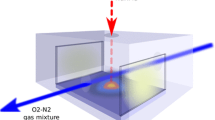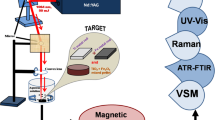Abstract
Titanium oxide nanoparticles are synthesized by laser ablation of Ti target in oxygen atmosphere under well-controlled temperature profiles in a tubular furnace. The size and the shape of generated nanoparticles are varied by changing the temperature of furnace. The mobility-based size distributions of generated air-borne nanoparticles are measured using a scanning mobility particle sizer, and the size distributions of primary particles are analyzed by a scanning electron microscope. When the particles are generated by laser ablation at the room temperature, the particles are agglomerates in gas phase with the average mobility diameter of 117 nm and the mean diameter of primary particles of 11 nm. The primary particle diameter increases from 11 to 24 nm by raising the furnace temperature up to 800 °C. Since the mass of Ti vapor ablated from a target is found to be constant regardless of the furnace temperature, this particle growth may be attributed to the reduction in nuclei number as a result of mild quenching at higher temperatures. As the temperature reaches higher than 1,000 °C, the mobility diameter suddenly drops and the primary particle diameter increases due to sintering, and at 1,200 °C the mobility diameter coincides with the primary particle diameter. Since the laser oven method offers an independent control of vapor concentration and the temperature of surrounding atmosphere, it is an effective tool to study the formation process of nanoparticles from primary particles with a given size.







Similar content being viewed by others
References
Camata RP, Hirasawa M, Okuyama K, Takeuchi K (2000) Observation of aerosol formation during laser ablation using a low-pressure differential mobility analyzer. J Aerosol Sci 31(4):391–401
Fujishima A, Honda K (1972) Electrochemical photolysis of water at a semiconductor electrode. Nature 238:37–38
Gaertner GF, Lydtin H (1994) Review of ultrafine particle generation by laser ablation from solid targets in gas flows. Nanostruct Mater 4(5):559–568
Guo T, Nikolaev P, Rinzler AG, Tomanek D, Colbert DT, Smalley RE (1995) Self-assembly of tubular fullerenes. J Phys Chem 99:10694–10697
Gurav A, Kodas T, Pluym T, Xiong Y (1993) Aerosol processing of materials. Aerosol Sci Technol 19:411–452
Hirasawa M, Orii T, Seto T (2004) Effect of insitu annealing on physical properties of Si nanoparticles synthesized by pulsed laser ablation. Appl Phys A 79:1421–1424
Hirasawa M, Orii T, Seto T (2006) Size-dependent crystallization of Si nanoparticles. Appl Phys Lett 88:093119
Hong S, Lee M, Park S, Lee G (2003) Synthesis of nanosized TiO2/SiO2 particles in the microemulsion and their photocatalytic activity on the decomposition of p-nitrophenol. Catal Today 87:99–105
Jang HD, Friedlander SK (1998) Restructuring of chain aggregates of titania nanoparticles in the gas phase. Aerosol Sci Technol 29:81–91
Kaneko K, Moon W, Inoue K, Horita Z, Ohara S, Adschiri T, Abe H, Naito M (2005) Characterization of TiO2–Ag nanocomposite particles prepared by spray pyrolysis process using transmission electron microscopy and three-dimensional electron tomography. Mater Sci Eng A 403:32–36
Kawasaki K, Despres JF, Kamei S, Ishikawab M, Odawara O (1997) Fabrication of nanometer-sized anatase particles by a pulsed laser ablation method. J Mater Chem 7(10):2117–2120
Khang Y, Lee J (2010) Synthesis of Si nanoparticles with narrow size distribution by pulsed laser ablation. J Nanopart Res 12:1349–1354
Kim C, Nakaso K, Xia B, Okuyama K, Shimada M (2005) A new observation on the phase transformation of TiO2 nanoparticles produced by a CVD method. Aerosol Sci Technol 39:104–112
Koch W, Friendlander SK (1990) The effect of particle coalescence on the surface area of a coagulation aerosol. J Colloid Interface Sci 140(2):419–427
Kruis FE, Kusters KA, Pratsinis SE (1993) A simple model for the evolution of the characteristics of aggregate particles undergoing coagulation and sintering. Aerosol Sci Technol 19:514–526
Li J-G, Ikeda M, Ye R, Moriyoshi Y, Ishigaki T (2007) Control of particle size and phase formation of TiO2 nanoparticles synthesized in RF induction plasma. J Phys D 40:2348–2353
Lide DR (2003–2004) CRC handbook of chemistry and physics, 84th edn. CRC Press, Boca Raton, pp 6–73
Matsui I (2006) Preparation of FePt magnetic nanoparticle film by plasma chemical vapor deposition for ultrahigh density data storage media. Jpn J Appl Phys 45:10B
Morales AM, Lieber CM (1998) A laser ablation method for the synthesis crystalline semiconductor nanowires. Science 279:208
Moser J, Gratzel M (1983) Light-induced electron transfer in colloidal semiconductor dispersions: single vs. dielectronic reduction of acceptors by conduction-band electrons. J Am Chem Soc 105:6547–6555
Nakaso K, Shimada M, Okuyama K, Deppert K (2002) Evaluation of the change in the morphology of gold nanoparticles during sintering. J Aerosol Sci 33:1061–1074
Nakaso K, Han B, Ahn KH, Choi M, Okuyama K (2003a) Synthesis of non-agglomerated nanoparticles by an electrospray assisted chemical vapor deposition (ES-CVD) method. J Aerosol Sci 34:869–881
Nakaso K, Okuyama K, Shimadaa M, Pratsinis SE (2003b) Effect of reaction temperature on CVD-made TiO2 primary particle diameter. Chem Eng Sci 58:3327–3335
Nedeljkovic JM, Saponjic ZV, Rakocevic Z, Jokanovic V, Uskokovic DP (1997) Ultrasonic spray pyrolysis of TiO2 nanoparticles. Nanostruct Mater 9:125–128
O’Regan B, Gratzel M (1991) A low-cost, high-efficiency solar cell based on dye-sensitized colloidal TiO2 films. Nature 353:737–740
Ogawa K, Vogt T, Ullmann M (2000) Elastic properties of nanoparticle chain aggregates of TiO2, Al2O3, and Fe2O3 generated by laser ablation. J Appl Phys 87(1):63–73
Okada T, Kawashima K, Nakata Y (2006) Nano-wire pig-tailed ZnO nano-rods synthesized by laser ablation. Thin Solid Films 506–507:274–277
Puretzky AA, Geohegan DB, Fan X, Pennycook SJ (2000) Dynamics of single-wall carbon nanotube synthesis by laser vaporization. Appl Phys A 70:153–160
Sakiyama K, Koga K, Seto T, Hirasawa M, Orii T (2004) Formation of size-selected Ni/NiO core–shell particles by pulsed laser ablation. J Phys Chem B 108:523–529
Schmidt-Ott A (1988) New approaches to in situ characterization of ultrafine agglomerates. J Aerosol Sci 19:553–563
Semaltianos NG (2010) Nanoparticles by laser ablation. Crit Rev Solid State Mater Sci 35:105–124
Seto T, Shimada M, Okuyama K (1995) Evaluation of sintering of nanometer sized titania using aerosol method. Aerosol Sci Technol 23:183–200
Seto T, Hirota A, Fujimoto T, Shimada M, Okuyama K (1997) Sintering of polydisperse nanometer-sized agglomerates. Aerosol Sci Technol 27:422–438
Seto T, Koga K, Akinaga H, Takano F, Orii T, Hirasawa M (2006) Laser ablation synthesis of monodispersed magnetic alloy nanoparticles. J Nanopart Res 8:371–378
Tsai M, Chenb S, Shena P (2005) Laser ablation condensation of TiO2 particles: effects of laser energy, oxygen flow rate and phase transformation. J Aerosol Sci 36:13–25
Tsyganov S, Kastner J, Rellinghaus B, Kauffeldt T, Westerhoff F, Wolf D (2007) Analysis of Ni nanoparticle gas phase sintering. Phys Rev B 75:045421
Ullmann M, Friedlander SK, Schmidt-Ott A (2002) Nanoparticle formation by laser ablation. J Nanopart Res 4:499–509
Wu MK, Friedlander SK (1993) Note on the power law equation for fractal-like aerosol agglomerates. J Colloid Interface Sci 159:246–248
Xiong Y, Pratsinis SE (1993) Formation of agglomerate particles by coagulation and sintering—part 1. A two-dimensional solution of the population balance equation. J Aerosol Sci 24:283–300
Xiong Y, Akhtar MK, Pratsinis SE (1993) Formation of agglomerate particles by coagulation and sintering—part 2. The evolution of the morphology of aerosol-made titania, silica and silica-doped titania powders. J Aerosol Sci 24:301–313
Yanagisawa K, Ovenstone J (1999) Crystallization of anatase from amorphous titania using the hydrothermal technique: effects of starting material and temperature. J Phys Chem B 103:7781–7787
Acknowledgments
The authors thank Dr. Kenji Koga at National Institute of Advanced Industrial Science and Technology for his help in carrying out the measurement by transmission electron microscope. This study was supported by a Grant-in-Aid for Scientific Research on Scientific Research (b) (No. 23360338) from the Ministry of Education, Culture, Sports, Science and Technology (MEXT) of Japan.
Author information
Authors and Affiliations
Corresponding author
Rights and permissions
About this article
Cite this article
Tsuji, M., Seto, T. & Otani, Y. Effect of surrounding gas temperature on the morphological evolution of TiO2 nanoparticles generated by laser ablation in tubular furnace. J Nanopart Res 14, 674 (2012). https://doi.org/10.1007/s11051-011-0674-7
Received:
Accepted:
Published:
DOI: https://doi.org/10.1007/s11051-011-0674-7




